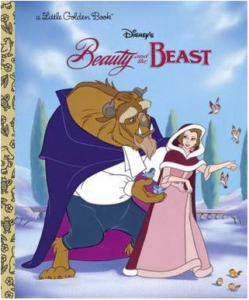When my middle child brought me this book to read aloud, no doubt gifted to my kids in a grab bag of books from my mother-in-law, I was pretty excited to do it. I grew up obsessed with my hardcover copy of Disney’s Cinderella, and Beauty And The Beast was one of my favorite Disney movies. So Joseph and his older brother Jms cuddled up to me while I read them the Golden Book Disney version of the classic fairy tale.
 And oh wow, were there lots of things here that I remembered quite differently! Granted, it’s been decades since I’ve watched the movie, and I certainly did not bother to watch the live-action version, cute as Dan Stevens is. And media novelizations, as it were, always have a habit of flattening the nuance of the stories they’re retelling. Not having the terrific tunes to sing along to certainly doesn’t help either! So I was surprised by how little I remembered of the animated movie’s actual plot, even as I questioned whether the things the book was choosing to emphasize were as egregiously told in the movie. Perhaps my hazy recollection softened the bad parts, but had I truly swallowed down misogyny so easily as a child?
And oh wow, were there lots of things here that I remembered quite differently! Granted, it’s been decades since I’ve watched the movie, and I certainly did not bother to watch the live-action version, cute as Dan Stevens is. And media novelizations, as it were, always have a habit of flattening the nuance of the stories they’re retelling. Not having the terrific tunes to sing along to certainly doesn’t help either! So I was surprised by how little I remembered of the animated movie’s actual plot, even as I questioned whether the things the book was choosing to emphasize were as egregiously told in the movie. Perhaps my hazy recollection softened the bad parts, but had I truly swallowed down misogyny so easily as a child?
Only one way to solve this conundrum: by putting on the movie once more. Even from watching the opening bit explaining the curse on the Prince who became a Beast, it’s clear that a lot of nuance has been removed from the book adaptation. The words mean the same thing but they carry different inflections. In the book, it seems that the Prince is cursed because he’s shallow, but in the movie, it’s clear that he is being cursed for the cruelty that comes from his shallowness. And omg, the book’s insistence that Belle is “not like other girls” made me question my entire liking for this movie: fortunately, my re-watch makes it clear that in the movie, she’s not like anyone else in their small provincial town. It’s weirdly reductive to limit the uniqueness of Belle’s personality to a phrase that reeks of internalized misogyny, and frankly a bad lesson to teach young readers.
The book also neglects to lay the framework for why the town deems Belle’s father mad, and how repulsive Gaston’s personality is, so it just looks like the townies are worse than they really are. Everyone is just really flat in a way that I don’t recall my beloved book adaptation of Cinderella being. Perhaps it’s a case of the author thinking that using smaller and fewer words will get the gist of the story across better. And while my kids enjoyed my telling of the story — complete with my asides of “Oh no, it isn’t that Belle isn’t like other girls, it’s that she’s so different from everyone else happy to live in their small country town” etc. — I felt rather ill at ease knowing these illiberal ideas were being passed off as innocuous, even wholesome reading.
Disney’s best movies succeed because they tell cute, sweet stories with fun music, and they’re beloved because their tales are almost universally heartwarming, which you can’t achieve without mindfully instilling nuance and empathy. This book, however, feels more like one of the tween mean girl Disney channel shows that I won’t let my kids watch. It’s not quite as bad as that, ofc, but I’m still glad I was around to provide commentary while introducing my kids to this story. Now I just have to persuade them to watch the movie again with me, for proper context, ofc.
Disney’s Beauty And The Beast by Teddy Slater, Ron Dias & Ric González was published November 1 1991 by Golden Books and is available from all good booksellers, including
